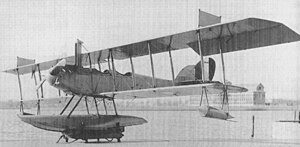Curtiss Model N
| Model N | |
|---|---|
 |
|
| Curtiss N-9H | |
| Role | floatplane |
| Manufacturer | Curtiss, Burgess Company |
| Designer | Glenn Curtiss |
| First flight | 1916 |
| Primary user | United States Navy |
| Number built | 560 |
The Curtiss N-9 was a floatplane variant of the Curtiss JN-4 "Jenny" military trainer used during World War I by the United States Navy.
As a seaplane, the N-9 was equipped with a single central pontoon mounted under the fuselage. A small float was fitted under each wingtip. With the additional weight of the pontoon, a number of structural and aerodynamic changes were required, the design of which made use of wind tunnel data developed at the Massachusetts Institute of Technology, meaning the N-9 was the first American naval aircraft to incorporate wind tunnel data directly into its design. The wingspan was stretched an additional ten feet (three meters), the fuselage was lengthened, the tail surfaces were enlarged, and stabilizing fins were added on top of the upper wing. The N-9 was initially powered by a 100 hp (75 kW) Curtiss OXX-6 engine.
Curtiss was awarded an initial contract for 30 aircraft in August 1916, and an additional 14 were ordered by the United States Army, which maintained a small seaplane operation. It quickly became apparent that the aircraft was underpowered, so Curtiss replaced the engine with a 150 hp (112 kW) Hispano-Suiza, manufactured in the United States under license by Wright-Martin's Simplex division (later Wright Aeronautical). The aircraft was redesignated N-9H.
A total of 560 N-9s were built during World War I, most of which were "H" models. Only 100 were actually built by Curtiss. Most were built under license by the Burgess Company of Marblehead, Massachusetts. Fifty others were assembled after the war, from spare components and engines by the U.S. Navy at Naval Air Station Pensacola in Florida.
...
Wikipedia
